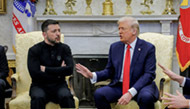By NELSON D. SCHWARTZ - PARIS
ONE OF THE most ominous effects of the global downturn is that many foreign central banks are rethinking the dollar’s status as the world’s premier reserve currency, experts are saying. That, in addition to domestic factors like historically low United States interest rates and a ballooning federal budget deficit, are worsening the dollar’s downward movement.
Over the long term, a weaker dollar could narrow the long-running United States trade deficit, helping close the gap between exports and imports, as American products become more affordable overseas.
But for those trying to export goods into the United States, such as as Italian suits, French wines, Japanese electronics and Argentine beef, it makes doing business more difficult as their wares become more expensive to Americans. The dollar’s drop is a central factor in oil’s recent rise back above $75 a barrel, which will mean higher gasoline prices.
But there is another upside, at least for Americans: a weak dollar could prove beneficial to the American economy by aiding long-suffering manufacturers, rebuilding a stronger industrial base and lifting exports even if it makes life harder for trading partners around the world, especially in Europe.
“As long as it doesn’t crash, a gradual, orderly decline is healthy, said C. Fred Bergsten, director of the Peterson Institute for International Economics. “The dollar went up 40 percent between 1995 and 2002, so this is a necessary rebalancing. Nevertheless, this has been the dollar’s fastest drop in six years; in recent weeks the dollar has neared $1.50 against the euro, compared with $1.25 in March. The pound has edged up against the dollar as well, from $1.41 in April to $1.64 this past week.
The political argument in America over the dollar’s trajectory is accompanied by a fierce debate among economists. “Dollar weakness is a major problem for American jobs and living standards, said David Malpass, a Wall Street economist and outspoken critic of the dollar’s decline.
“As the dollar devalues, we have less capital and purchasing power compared to the rest of the world, and there is an increasing risk of higher interest rates and inflation, Mr. Malpass said.
But Mr. Bergsten argues the dollar is only now getting back to a fair valuation against other currencies if the United States is to continue to close its trade gap.
With the recent drop, he said, the dollar is fairly valued against the euro but needs to ease 10 percent against Asian currencies like the Japanese yen to create a level playing field for American business. And for all the fluctuations against the dollar by major currencies, the dollar has not moved at all recently against the Chinese renminbi, which is managed by Beijing in ways that allow Chinese exporters to enjoy a weaker currency and gain market share worldwide.
The Treasury secretary, Timothy F. Geithner, has consistently said the administration favors a strong dollar, but currency markets focus on the unlikely prospect of concrete action, like an interest rate increase.
“The Obama administration may say they want a strong dollar, said Neil Mellor, a currency strategist at BNY Mellon Global Markets in London. “But everyone knows they haven’t got the means to support it. The Federal Reserve can’t raise rates, and the White House can’t cut the budget deficit anytime soon.
If the dollar does keep falling and the euro keeps rising, it could increase trade tensions with Europe, especially big exporters like Germany, which have already been hard hit by the global economic slump.
“The strength of the euro is coming at absolutely the wrong time, said Jens Nagel, head of the international department of the German Exporters Association in Berlin. “The U.S. is our biggest trading partner after the European Union, and it’s a big blow to the recovery of auto companies and industrial exporters.
Mr. Mellor predicts the dollar will keep dropping, reaching $1.60 against the euro by early next year.
As the global economy recovers and international manufacturers ramp up output, they are giving priority to their more competitive plants, including those in the United States, said Pierre Dufour, senior executive vice president at Air Liquide, a French supplier of industrial gases to steelmakers, semiconductor firms, and other industrial giants worldwide.
“It has two sides, like it always does, said Carl Martin Welcker, owner of a machine tools maker, Schutte, in Cologne, Germany. “On the one hand, it makes our machines significantly more expensive, said Mr. Welcker, whose equipment churns out 80 percent of the world’s spark plugs.
“On the other hand, we’re seeing international companies move production back to the U.S., which helps our sales there.
스마터리빙
more [ 건강]
[ 건강]이제 혈관 건강도 챙기자!
[현대해운]우리 눈에 보이지 않기 때문에 혈관 건강을 챙기는 것은 결코 쉽지 않은데요. 여러분은 혈관 건강을 유지하기 위해 어떤 노력을 하시나요?
 [ 건강]
[ 건강]내 몸이 건강해지는 과일궁합
 [ 라이프]
[ 라이프]벌레야 물럿거라! 천연 해충제 만들기
 [ 건강]
[ 건강]혈압 낮추는데 좋은 식품
[현대해운]혈관 건강은 주로 노화가 진행되면서 지켜야 할 문제라고 인식되어 왔습니다. 최근 생활 패턴과 식생활의 변화로 혈관의 노화 진행이 빨라지고
사람·사람들
more많이 본 기사
- [‘로드 레이지’ 한인 피살 현장 상세 상황] 끼어들기 시비가 비극으로… 차에서 내려 “쏴봐라” 언쟁
- [이민 단속] 여권 소지 시민권자들 … 1
- 크리스마스 대형 폭풍… 침수·산사태 대비 ‘비상’
- [성탄절 문 여는 곳은] 코스코·월마트 닫고… CVS는 영업
- 가난해서 흙 팠는데… ‘다이아’ 캤다
- 취업비자(H-1B), 고연봉자 우선 발급
- [이민 단속] 새해에도 더 공격적 단속
- 연방대법, 시카고 주방위군 투입 ‘기각’
- MC몽, 차가원 회장 충격 불륜 부인.. “채무 120억 당연히 이행”
- 두 손 모아 성탄기도… “온 세상에 평화를”
- 우크라, 20개항 종전안 최신판 공개…영토 할양은 ‘미해결’
- 뉴욕한국라이온스클럽· 뉴욕한인합창단 한 해 마무리 합동 송년회 성황
- [부 고] 박종군 전 뉴욕청과협회장 별세
- ‘마약 혐의’ 남양유업 창업주 외손녀 황하나 경찰에 체포
- 군 장교에서 글로벌 교육 리더로‘제2의 인생’ 을 살다
- 역주행 승용차 덮쳐 한인 등 2명 사망
- “온 세상에 평화를⋯”
- 이대우 뉴저지한인회장, “적자 개인적으로 전액변제”
- 트럼프, ‘나비넥타이’ 매고 연말 대중문화 시상식 일부 진행
- H-1B비자 고임금·경력자에 우선권
- 차기 대선 선호도… 공화 ‘밴스’ ·민주 ‘뉴섬’ 선두
- 해병대전우회 동부연합회·뉴욕해병대전우회 송년회
- 트럼프 “마두로 물러나라” 최후통첩
- 뉴욕시 최저임금 인상⋯ 1월1일부터 17달러
- 불체자 자진출국하면 지원금 3배로 ‘3천불’
- 비전케어 USA 무료 백내장 수술
- 윌리엄 컬렌 브라이언트 고교 한국어반 삼성전자 북미사옥 현장학습
- 엡스타인 자료 추가 공개… “전용기에 트럼프 8번 타”
- 트럼프 행정부, H-1B비자 추첨 내년 2월 폐지…고임금 인력 우대
- [삶과 생각] 제도화된 불법, 합법의 가면을 쓴 민주주의 붕괴
- 아시안아메리칸사법경찰자문위원회 송년회
- [‘로드 레이지’ 한인 피살 현장 상세 상황] 끼어들기 시비가 비극으로… 차에서 내려 “쏴봐라” 언쟁
- 뉴저지한국학교 종강식^ 학습발표회
- 46회째 1등 안나온 파워볼 복권 당첨금 17억달러로 껑충 뛰어
- ‘파워볼’ 열풍 계속… 오늘 잭팟상금 17억 달러
- 롱아일랜드한국학교 종강식
- 해외서도 극과극 반응’대홍수’, 넷플릭스 글로벌 1위 차지”SF 걸작 vs 최악”
- 온라인쇼핑과 반품, 그리고 그 이후 1
- 트럼프의 새 독트린 “미국을 다시 왜소하게”
- 정동원, 내년 2월 23일 해병대 입대..전역 예정일은 27년 8월 22일
- [미국은 지금] MAGA의 분열, 예… 1
- 퀸, 51년 전 ‘미발표곡’ 공개 녹음 뒤 앨범에 안 담긴 곡
- 한국계 타자 레프스나이더 시애틀과 625만달러 1년 계약
- [남가주 6개 은행 전국 예금 현황] 1억달러 이상 예금고 지점 99개
- 미 해군 군함 명칭 전통 깬 ‘트럼프급 전함’
- ‘100억달러 수주’ 한화오션, 내년 FPSO 시장 노린다
- 이하늬, 기획사 미등록 혐의 검찰 송치.. “10월 정식 등록”
- “국악 아름다움 나눠요”
- “샌디에고와 100점짜리 계약 체결… 마차도와 호흡 기대”
- “은·로빈후드·인공지능 주식에 집중 투자”
1/5지식톡

-
 미 육군 사관학교 West Poin…
0
미 육군 사관학교 West Poin…
0https://youtu.be/SxD8cEhNV6Q연락처:wpkapca@gmail.comJohn Choi: 714-716-6414West Point 합격증을 받으셨나요?미 육군사관학교 West Point 학부모 모…
-
 ☝️해외에서도 가능한 한국어 선생님…
0
☝️해외에서도 가능한 한국어 선생님…
0이 영상 하나면 충분합니다!♥️상담신청문의♥️☝️ 문의 폭주로 '선착순 상담'만 진행합니다.☎️ : 02-6213-9094✨카카오톡ID : @GOODEDU77 (@골뱅이 꼭 붙여주셔야합니다…
-
 테슬라 자동차 시트커버 장착
0
테슬라 자동차 시트커버 장착
0테슬라 시트커버, 사놓고 아직 못 씌우셨죠?장착이 생각보다 쉽지 않습니다.20년 경력 전문가에게 맡기세요 — 깔끔하고 딱 맞게 장착해드립니다!장착비용:앞좌석: $40뒷좌석: $60앞·뒷좌석 …
-
 식당용 부탄가스
0
식당용 부탄가스
0식당용 부탄가스 홀세일 합니다 로스앤젤레스 다운타운 픽업 가능 안녕 하세요?강아지 & 고양이 모든 애완동물 / 반려동물 식품 & 모든 애완동물/반려동물 관련 제품들 전문적으로 홀세일/취급하는 회사 입니다 100% …
-
 ACSL 국제 컴퓨터 과학 대회, …
0
ACSL 국제 컴퓨터 과학 대회, …
0웹사이트 : www.eduspot.co.kr 카카오톡 상담하기 : https://pf.kakao.com/_BEQWxb블로그 : https://blog.naver.com/eduspotmain안녕하세요, 에듀스팟입니다…
케이타운 1번가
오피니언
 정숙희 논설위원
정숙희 논설위원온라인쇼핑과 반품, 그리고 그 이후
 파리드 자카리아 / 워싱턴포스트 칼럼니스트 / CNN ‘GPS’ 호스트
파리드 자카리아 / 워싱턴포스트 칼럼니스트 / CNN ‘GPS’ 호스트 트럼프의 새 독트린 “미국을 다시 왜소하게”
 김동찬 시민참여센터 대표
김동찬 시민참여센터 대표 [미국은 지금] MAGA의 분열, 예견된 균열의 시작
 임지영 (주)즐거운 예감 한점 갤러리 대표
임지영 (주)즐거운 예감 한점 갤러리 대표 [수요 에세이] 삶이라는 배를 타고
 이영창 / 한국일보 기자
이영창 / 한국일보 기자[지평선] ‘인간GPT’ 환각의 부작용
 조환동 / 편집기획국장·경제부장
조환동 / 편집기획국장·경제부장 AI로 가속화되는 노동시장 개편
 민경훈 논설위원
민경훈 논설위원‘크리스마스 캐롤’과 산타 클로스
 정재민 KAIST 문술미래전략 대학원 교수
정재민 KAIST 문술미래전략 대학원 교수 [정재민의 미디어풍경] 적과의 동침, 협력하며 경쟁하기
 김영화 수필가
김영화 수필가 [화요칼럼] 단호박의 온기
1/3지사별 뉴스

“온 세상에 평화를⋯”
숨가쁘게 달려온 2025년을 이제 1주일 남짓 남긴 채 크리스마스 이브를 맞는다. 다사다난했던 한 해를 되돌아보며 마무리하는 연말 시즌과 크리…
H-1B비자 고임금·경력자에 우선권

‘올해는 ICE 이민자 체포 광풍의 해’
올 한해동안 버지니아와 메릴랜드, DC 등에서 연방 이민당국에 체포된 사람이 1만명이 훌쩍 넘는 것으로 조사됐다. 또 미 전국적으로는 22만명…
“ATM기 사용하기 겁나네”

연말 ‘로드레이지’ 비극… 한인 총격 피살
연말을 맞아 도로 위에서 순간적으로 벌어진 운전 중 시비가 40대 한인 가장의 총격 피살 비극으로 이어졌다. 워싱턴주 레이시 경찰국과 서스턴 …
[‘로드 레이지’ 한인 피살 현장 상세 상황] 끼어들기 시비가 비극으로… 차에서 내려 “쏴봐라” 언쟁

오늘 하루 이 창 열지 않음 닫기 























































.png)


댓글 안에 당신의 성숙함도 담아 주세요.
'오늘의 한마디'는 기사에 대하여 자신의 생각을 말하고 남의 생각을 들으며 서로 다양한 의견을 나누는 공간입니다. 그러나 간혹 불건전한 내용을 올리시는 분들이 계셔서 건전한 인터넷문화 정착을 위해 아래와 같은 운영원칙을 적용합니다.
자체 모니터링을 통해 아래에 해당하는 내용이 포함된 댓글이 발견되면 예고없이 삭제 조치를 하겠습니다.
불건전한 댓글을 올리거나, 이름에 비속어 및 상대방의 불쾌감을 주는 단어를 사용, 유명인 또는 특정 일반인을 사칭하는 경우 이용에 대한 차단 제재를 받을 수 있습니다. 차단될 경우, 일주일간 댓글을 달수 없게 됩니다.
명예훼손, 개인정보 유출, 욕설 등 법률에 위반되는 댓글은 관계 법령에 의거 민형사상 처벌을 받을 수 있으니 이용에 주의를 부탁드립니다.
Close
x